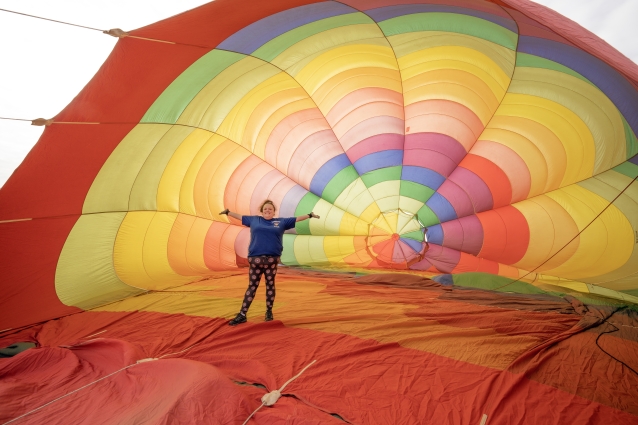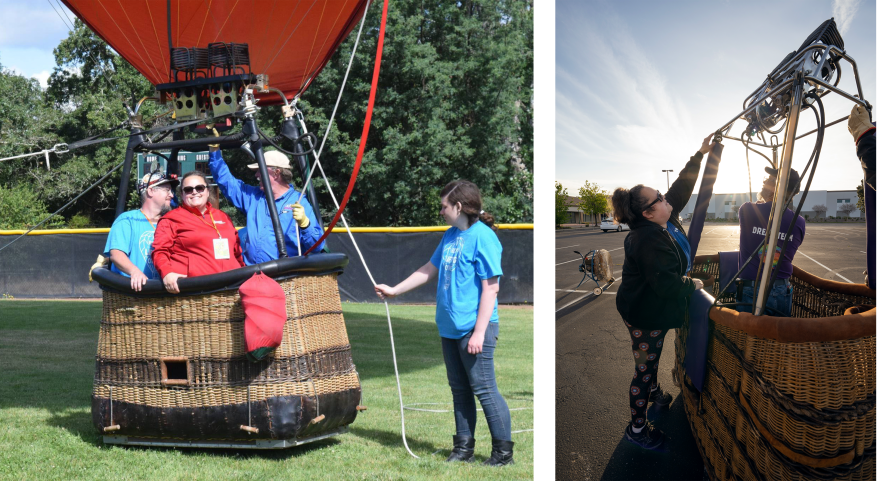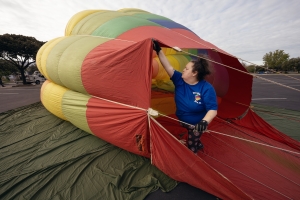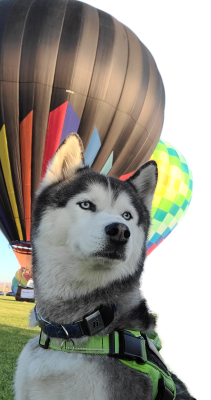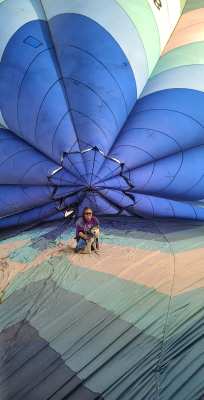Photo by Blaise Douros/LLNL.
It started with a pledge to volunteer, driving a golf cart to collect money from various booths. But for Melanee Scarborough and her husband, their volunteering at that year’s Sonoma County Hot Air Balloon Classic escalated into a love of hot air ballooning.
Surprisingly, Scarborough, one of the hiring administrators and scholar coordinator for the Lab’s Materials Engineering Division, is not particularly fond of flying.
“I think they are beautiful, I love educating people about them, but I don’t like to fly,” she said. “I prefer to stay on the ground. I’m scared of heights and it’s just not something that I’m very excited about.”
But that wasn’t the same experience for her husband, Joe Lamberti. That first volunteer opportunity, he operated the tether fields for the day and was hooked. Tethering means the balloon is tied to the ground with ropes. This allows the balloon to rise anywhere from 100 to 300 feet off the ground and then come back down. This is especially comforting to people who are fearful of getting into a hot air balloon but want to “give it a try.”
“It [tethering] gives them the taste of what it feels like to be off the ground and be lighter than air,” Scarborough said.
From there the couple volunteered at many events either crewing (prepping the balloon on the ground for flight) or tethering. “We really got involved in crewing for pilots and learning the sport,” she said. “When Joe decided he wanted to get more involved, it was kind of perfect. He runs the flight in air and I run the ground.”
The duo continues to help out with local festivals and even a summer camp for teenagers where they can learn all about ballooning from the ground up. “That’s how we keep the sport alive,” Scarborough said.
While Lamberti is still training to be a full flight pilot, they both learned the craft by crewing for others to hone their skills. “That’s what was really important for us to be able to crew for as many different pilots as we can. That first year we crewed for 20 pilots at more than 30 different events. So that when we did make the decision to become a team, we took pieces from everything that we learned and made it our own,” she said.
Their own is “Technicolor Dream,” which the couple bought in 2019. They often fly out of Tracy Airport or San Martin Airport in Salinas. Ideal weather is the key: in the 60s and low 70s, no precipitation, no fog and wind at only one to three miles per hour.
A trek worthy of breakfast
Getting a balloon ready for flight includes many steps. Upon arriving at the airfield very early, Scarborough checks in with her crew. Everyone is made aware of the plans for the day and safety protocols are reviewed. From there, the team begins unloading the balloon assembly from the trailer. Lamberti makes the decision if they will use a ground tarp (depending on where they are launching from) and that will go down first. From there, the basket is assembled, the burners are tested and then the basket is laid on its side to connect to the balloon (also called an envelope). Once connected to the basket, the envelope is pulled out of the bag so that it lays flat on the ground before inflation. The crew then sets into a predetermined assignments and prepares for the “cold inflation.”
(Right) Scarborough helps attach the fan for inflation. Photo by Blaise Douros /LLNL.
A crown person is responsible for stabilizing the top of the balloon. They hold a rope and serve as a counterweight to stabilize and prevent the balloon from standing too quickly. Other crew members will hold open the mouth (throat) of the balloon and another will run the fan. Lamberti then gives the green light to start cold inflation where the fan blows in cold air and the balloon starts to inflate and gets big and round.
Then comes the pièce de resistance: the balloon goes hot and slowly starts to rise. Once standing, there is a series of checks from burners, propane, radios and of course the kiss goodbye, before Lamberti goes light and off into the great blue sky. Scarborough then gathers the crew together, packs all the remaining gear in the trailer and waits. Will Lamberti be landing back on the launch field or will weather conditions change and he lands somewhere else?
on the balloon. Photo by Blaise Douros /LLNL.
“We stay at the launch site and see which direction he’s headed,” Scarborough said. “I do a radio check to make sure that our radios are working and we can hear one another. And then we watch the balloon. A lot of times we just wait and see what happens. When he lets me know he’s ready to land or I see that he’s descending to land, then our job is to be there to help him when he lands. I’m always a little worried because anything can happen,” she said. “I know it’s something Joe enjoys. I know all the safety that surrounds it. You never know what’s going to happen in life. He’s doing something he enjoys. As long as we continue to enjoy it, we’ll continue doing it for a as long as we can. That’s why I always make sure that I get that kiss before he leaves.”
The whole trek, from leaving home to the field, flying, packing up and heading home is all in a morning’s work. Then, Lamberti and Scarborough treat the crew to breakfast.
A vital crew member
Lamberti and Scarborough have a member of their crew that is most vital, a Siberian Husky named Blu.
During the pandemic, Lamberti, a health care worker, was in his office daily while Scarborough was working at home. Just she and Blu, always by her side. She noticed he started to wake her up the same time every morning.
companion, but also a service dog.
semi-inflated Technicolor Dream
with her dog Blu.
“I just thought he was lonely,” said Scarborough, who is diabetic. “And then I realized I was having a sugar problem.”
Service dogs are typically trained as puppies into early adulthood. However, Blu did not receive formal training as a pup. “I wasn’t quite sure what he was doing,” she said.
Scarborough called a friend from the American Diabetes Association who put her in touch with a person that trains diabetic alert dogs (also known as DADs). What she found out was that the body produces a different scent when a person has high or low blood sugar and dogs, with their keen sense of smell, can pick up on that.
With a bit of training, Scarborough found out Blu had a natural talent to be a lifesaver. Following the guidelines set forth in the DAD training, Blu was able to successfully complete the courses and became a certified diabetic alert dog. Blu goes to ballooning events and joins her onsite from time to time, always keeping an eye on Scarborough.
“I’m very lucky to have my Blu dog, “He literally has saved my life.” – Melanee Scarborough
Scarborough is very excited to be leading the charge of a brand-new hot air balloon festival that will debut this summer in the city of Ceres. She also is on the board for the Pacific Coast Aeronauts, which is a Northern California Hot Air Balloon Club full of hot air enthusiasts.

